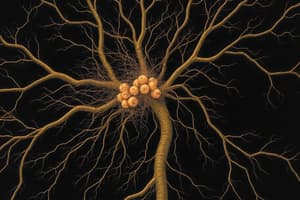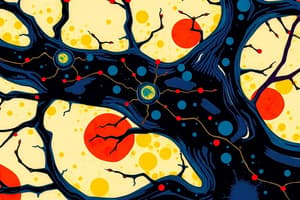Podcast
Questions and Answers
Which of the following is not an effect of the sympathetic nervous system?
Which of the following is not an effect of the sympathetic nervous system?
- Heart rate increases
- Respiration increases
- Pupils dilate
- Digestion increases (correct)
Which cranial nerve is primarily responsible for balance and equilibrium?
Which cranial nerve is primarily responsible for balance and equilibrium?
- Trochlear
- Trigeminal
- Hypoglossal
- Vestibulocochlear (correct)
Which lobe of the brain is primarily involved in planning and problem-solving?
Which lobe of the brain is primarily involved in planning and problem-solving?
- Temporal
- Parietal
- Occipital
- Frontal (correct)
Which structure connects the third and fourth ventricles of the brain?
Which structure connects the third and fourth ventricles of the brain?
Which is the middle layer of the meninges?
Which is the middle layer of the meninges?
Which cranial nerve is motor to the trapezius muscle?
Which cranial nerve is motor to the trapezius muscle?
Which lobe of the brain primarily processes visual information?
Which lobe of the brain primarily processes visual information?
Which type of neuron is responsible for myelin production in the central nervous system?
Which type of neuron is responsible for myelin production in the central nervous system?
What is the primary function of the cerebrospinal fluid (CSF)?
What is the primary function of the cerebrospinal fluid (CSF)?
Which layer of the meninges is directly in contact with the brain and spinal cord?
Which layer of the meninges is directly in contact with the brain and spinal cord?
What structure forms the cerebrospinal fluid by filtration of blood plasma?
What structure forms the cerebrospinal fluid by filtration of blood plasma?
Which of the following correctly describes the relationship between the arachnoid mater and pia mater?
Which of the following correctly describes the relationship between the arachnoid mater and pia mater?
Where does the cerebrospinal fluid flow after being produced in the ventricles?
Where does the cerebrospinal fluid flow after being produced in the ventricles?
What is the main function of the anterior (ventral) root of the spinal nerve?
What is the main function of the anterior (ventral) root of the spinal nerve?
In which ventricle does the cerebral aqueduct permit the flow of CSF?
In which ventricle does the cerebral aqueduct permit the flow of CSF?
Which plexus is responsible for supplying nerves to the lower extremities?
Which plexus is responsible for supplying nerves to the lower extremities?
What is the name of the opening that connects the lateral ventricles to the third ventricle?
What is the name of the opening that connects the lateral ventricles to the third ventricle?
What are the basic components of a reflex arc?
What are the basic components of a reflex arc?
What happens to cerebrospinal fluid in the cranial venous sinuses?
What happens to cerebrospinal fluid in the cranial venous sinuses?
Which structure connects the cerebrum to the spinal cord?
Which structure connects the cerebrum to the spinal cord?
What is the thickest and toughest outermost layer of the meninges?
What is the thickest and toughest outermost layer of the meninges?
Which part of the brain is divided into right and left cerebral hemispheres?
Which part of the brain is divided into right and left cerebral hemispheres?
Which nerve arises from the cervical plexus and activates the diaphragm?
Which nerve arises from the cervical plexus and activates the diaphragm?
What is the primary function of the medulla oblongata?
What is the primary function of the medulla oblongata?
Flashcards
Middle meningeal layer
Middle meningeal layer
The arachnoid mater is the middle layer of the meninges.
Superior brainstem part
Superior brainstem part
The midbrain is the most superior part of the brainstem.
Lobe for planning
Lobe for planning
The frontal lobe processes planning and concentration.
Vision processing lobe
Vision processing lobe
Signup and view all the flashcards
3rd and 4th ventricle connector
3rd and 4th ventricle connector
Signup and view all the flashcards
CSF reabsorption structure
CSF reabsorption structure
Signup and view all the flashcards
Balance and Equilibrium nerve
Balance and Equilibrium nerve
Signup and view all the flashcards
Trapezius motor nerve
Trapezius motor nerve
Signup and view all the flashcards
Sympathetic nervous system non-effect
Sympathetic nervous system non-effect
Signup and view all the flashcards
CNS myelin producer
CNS myelin producer
Signup and view all the flashcards
Arachnoid Mater
Arachnoid Mater
Signup and view all the flashcards
Pia Mater
Pia Mater
Signup and view all the flashcards
Subarachnoid Space
Subarachnoid Space
Signup and view all the flashcards
Cerebrospinal Fluid (CSF)
Cerebrospinal Fluid (CSF)
Signup and view all the flashcards
Ventricles
Ventricles
Signup and view all the flashcards
Choroid Plexus
Choroid Plexus
Signup and view all the flashcards
Lateral Ventricles
Lateral Ventricles
Signup and view all the flashcards
Interventricular Foramen
Interventricular Foramen
Signup and view all the flashcards
Third Ventricle
Third Ventricle
Signup and view all the flashcards
Cerebral Aqueduct
Cerebral Aqueduct
Signup and view all the flashcards
Fourth Ventricle
Fourth Ventricle
Signup and view all the flashcards
Arachnoid Villi
Arachnoid Villi
Signup and view all the flashcards
Anterior (Ventral) Root
Anterior (Ventral) Root
Signup and view all the flashcards
Posterior (Sensory) Root
Posterior (Sensory) Root
Signup and view all the flashcards
Spinal Nerve
Spinal Nerve
Signup and view all the flashcards
Nerve Plexus
Nerve Plexus
Signup and view all the flashcards
Cervical Plexus
Cervical Plexus
Signup and view all the flashcards
Brachial Plexus
Brachial Plexus
Signup and view all the flashcards
Lumbosacral Plexus
Lumbosacral Plexus
Signup and view all the flashcards
Sciatic Nerve
Sciatic Nerve
Signup and view all the flashcards
Reflex Arc
Reflex Arc
Signup and view all the flashcards
Cerebrum
Cerebrum
Signup and view all the flashcards
Cerebellum
Cerebellum
Signup and view all the flashcards
Diencephalon
Diencephalon
Signup and view all the flashcards
Brain Stem
Brain Stem
Signup and view all the flashcards
Meninges
Meninges
Signup and view all the flashcards
Study Notes
Nervous System Overview
- The nervous system is a complex system, responsible for bodily functions.
- It detects changes, feels sensations, initiates responses and organizes information.
- Functions are directly related to normal physiology and homeostasis.
Learning Objectives
- Identify the divisions and parts of the nervous system.
- Detail the components and function of a neuron.
- Understand the role of Schwann cells and neuroglia.
- Explain nerve impulse transmission and synapse function.
- Detail types of neurons and nerve tracts.
- Locate and describe spinal nerves, functions of brain parts.
- Define meninges and cerebrospinal fluid.
- Describe cranial nerves and their functions.
- Explain the sympathetic and parasympathetic nervous system's roles in stress response and normal functioning.
Nervous Tissue
- Neurons: Functional units of the nervous system.
- Cell body: Contains nucleus and organelles; regulates neuron function.
- Dendrites: Receive impulses, carry towards cell body.
- Axon: Carries impulses away from cell body.
- Myelin sheath: Multilayered lipid/protein covering (Schwann cells in PNS, oligodendrocytes in CNS); allows rapid impulse conduction.
- Nodes of Ranvier: Gaps in myelin sheath.
- Neuroglia (glial cells): Non-neuronal cells of the CNS.
- Oligodendrocytes: Produce myelin in CNS.
- Microglia: Phagocytes of pathogens and damaged tissue.
- Astrocytes: Support neurons and maintain chemical environment.
- Ependymal cells: Line ventricles and central canal, circulate cerebrospinal fluid.
Nerve Tissue (cont'd)
- White matter: Myelinated axons of many neurons in CNS
- Gray matter: Primarily cell bodies of neurons in CNS
- Types of neurons:
- Sensory (afferent): Carry impulses from receptors to CNS.
- Motor (efferent): Carry impulses from CNS to effectors (muscles/glands).
- Nerve: Bundle of neuronal axons/dendrites outside the CNS.
- Sensory: Only sensory neurons
- Motor: Only motor neurons
- Mixed: Both sensory and motor neurons
- Nerve tract: Bundle of nerve axons within the CNS.
Nerve Impulse
- Polarization: Resting state; positive outside, negative inside.
- Depolarization: Stimulus causes Na+ ions to enter membrane; reverses charge.
- Propagation: Impulse travels from stimulus point.
- Saltatory Conduction: Rapid impulse transmission between nodes of Ranvier.
- Repolarization: K+ ions exit; restores original charge.
Spinal Cord
- Encased in vertebral canal
- Gray matter: Cell bodies of motor neurons and interneurons
- White matter: Myelinated axons of neurons
- Contains cerebrospinal fluid
Spinal Cord (cont'd)
- Functions:
- Conducts sensory impulses to brain
- Conducts motor impulses from brain to muscles/glands
- Reflex activities (simple, rapid, autonomic responses)
- Spinal nerves: 31 pairs
- Cervical plexus
- Brachial plexus
- Lumbosacral plexus
Reflex Arc
- Components:
- Receptor
- Sensory neuron (afferent)
- Integrating center (in CNS)
- Motor neuron (efferent)
- Effector (muscle/gland)
- Involuntary response to a stimulus
Brain
- Cerebrum: Largest part, divided into hemispheres.
- Main areas: Frontal, parietal, temporal, occipital lobes.
- Diencephalon: Between cerebrum and brain stem (thalamus, hypothalamus, pineal gland).
- Cerebellum: Below cerebrum; coordinates movement and balance.
- Brainstem: Connects cerebrum and diencephalon with spinal cord.
- Midbrain, pons, medulla oblongata.
Cranial Nerves
- 12 pairs emerging from brain; sensory, motor, or mixed functions.
- Examples: Olfactory, optic, oculomotor, trochlear.
Autonomic Nervous System (ANS)
- Part of PNS; controls involuntary functions.
- Sympathetic: "Fight or flight" responses (increase heart rate, dilate pupils etc.)
- Neurotransmitter: Norepinephrine
- Parasympathetic: "Rest and digest" responses (slow heart rate, constrict pupils etc.)
- Neurotransmitter: Acetylcholine
Additional Information
- Meninges: Protective membranes surrounding brain and spinal cord (dura mater, arachnoid mater, pia mater).
- Cerebrospinal fluid (CSF): Clear fluid surrounding brain and spinal cord for cushion and nutrient transport and waste removal.
- Ventricles: Spaces in the brain containing CSF.
- Neuroplasticity: Brain's ability to adapt and reorganize itself.
- Reflex actions: Automatic responses protecting the body from harm.
- Brain can store vast amounts of information.
Studying That Suits You
Use AI to generate personalized quizzes and flashcards to suit your learning preferences.



